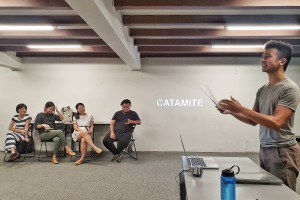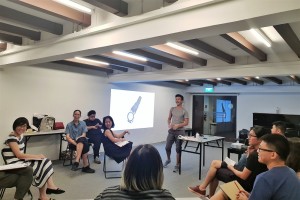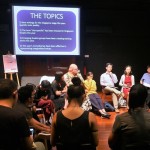
Loo Zihan hopes to explore the relationship between objects, memories, and identity in “Catamite”. Photo: Tom Giebel
Multidisciplinary artist Loo Zihan is no stranger to our blue house. He was one of our first ever Basement Workshop artists in residence, and developed and staged With/Out here for the 2015 M1 Singapore Fringe Festival. Four years later, he has returned to create a one-man show called Catamite for the 2019 edition of the same festival, to be performed at Centre 42 from 25 to 27 January.
The idea for this new work came about when he was writing the thesis for his Performance Studies Master’s degree in New York recently, and used the opportunity to reflect on his own artistic practice.
“I was looking at works that I’ve done in the past through a critical lens, and I kept coming back to this installation that I did at the Institute of Contemporary Arts at Lasalle in 2016, called Queer Objects: an archive for the future,” he shares. “It was still very fresh, and it was something I haven’t really worked through, unlike With/Out [which I revisited at Esplanade in 2017]. So I wanted to come back to it.”
He explains that in a way, he had unfinished business with Queer Objects. The piece imagines that in the year 2065, Section 377A of the Penal Code in Singapore – which criminalises sex between men – has been repealed, and objects from a time capsule are unearthed and displayed. The exhibition actually comprised items loaned to him by members from the local queer community that they associated with their identity. It got a lot of attention, but not really of the sort that Zihan was hoping for: a few items from the collection were deemed too offensive, and removed just before the show opened.

Zihan has been working on “Catamite” under Basement Workshop, and has been conducting trial runs here recently.
There was one such seemingly mundane object from that exhibition that he’s especially keen to re-examine: a watch whose face and strap look like they came from different eras. Zihan is fascinated by the lovely story behind it, which led him to consider the kind of narratives that objects can contain.
“I am drawn to objects that hold a symbolic weight in archives, especially narratives that have been historically suppressed or proscribed. I am also trying to understand why some objects have been tethered to memories, while others have been disconnected and neglected,” he muses. “Through the tracking of what memories and objects have been given significance, we can measure what society’s, or an individual’s, values are, and how they evolve over time.”
Incidentally, a watch also cropped up in a separate story when he was researching the history behind how Section 377A came about. Through newspaper archives and his conversations with legal scholar George Baylon Radics, Zihan discovered the case of Captain Douglas Marr and a male prostitute – also known as a catamite – called Sudin bin Daud. They were two of the first people in Singapore to be charged with Section 377A back in the early 1940s, and the main piece of evidence that was used to prove their alleged relationship was a timepiece that Sudin had stolen from the captain.
Both Zihan’s Queer Objects exhibition and his research on Section 377A will form the basis of Catamite, with the humble watch linking the two threads, and serving as a metaphor for the passing and verification of time.
The performance will be divided into five parts, comprising a series of participatory exercises as well as lecture-performances. But even though the work traces Section 377A all the way from the 1940s well into the future, Zihan is clear that it is not a history lesson.

One object that inspired Zihan in the creation of “Catamite” is a watch loaned to him for an earlier installation work.
“If you’re coming in expecting a lecture, that’s not really going to be the case,” he emphasises. “That said, my practice has been about providing people with knowledge and information, to understand that there are multiple historical narratives. So for me, the biggest responsibility of Catamite is to help people understand where 377A came from. Whether they are for repeal or not is up to them, and I don’t think that’s something I can possibly change through one performance. It’s just to give them information so that they can make an informed decision on the eventual position that they would like to adopt.”
The work will be performed in our Black Box, which happens to be where part of his 2015 production of With/Out took place as well.
“It’s nice that in Catamite, when I talk about the candle from Paddy [Chew]’s performance [of Completely With/Out Character, on which With/Out was based] – which was also one of the objects in the Queer Objects archive – then I can talk about the moment when I lit it in that very same space in the Black Box,” he says. “When I first did With/Out here, it was a new space and it was exciting. But now, coming back, there’s a certain complexity and richness that accumulates over time, by coming to the same space and working in the same space over and over again. It’s a different relationship, and adds layers of complexity to the work itself.”
Catamite is also an open invitation for audiences to explore the relationship between objects, memories, and identity. And in that sense, it’s also been a rather nice way to resurface Zihan’s own memories and relationship with the space, as well as the objects associated with it.
By Gwen Pew
Published on 11 January 2019
Catamite will be performed at Centre 42 from 25 to 27 January. Tickets are available here.





